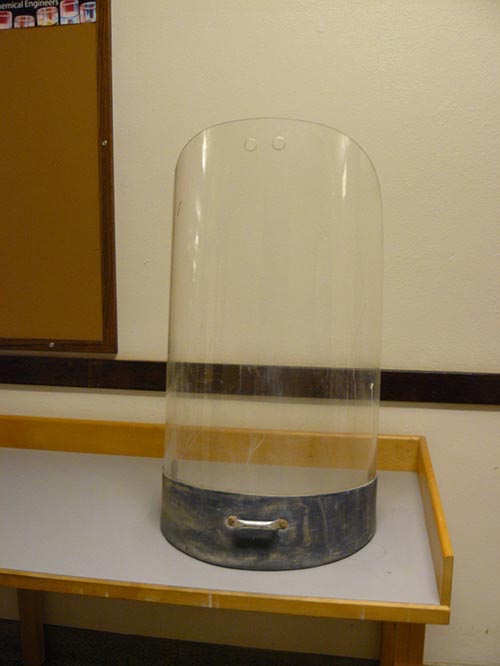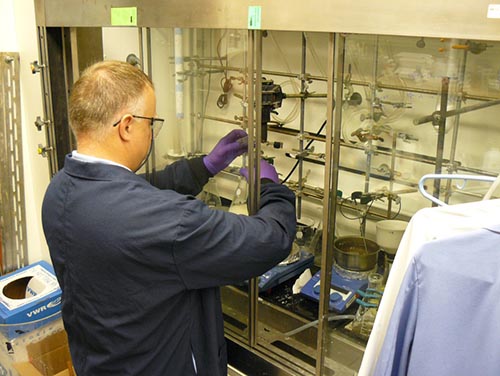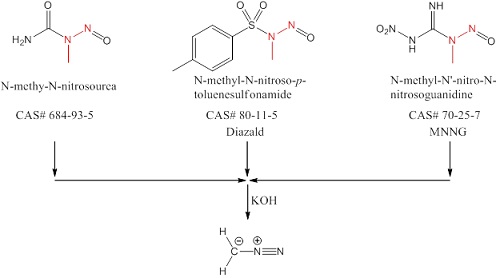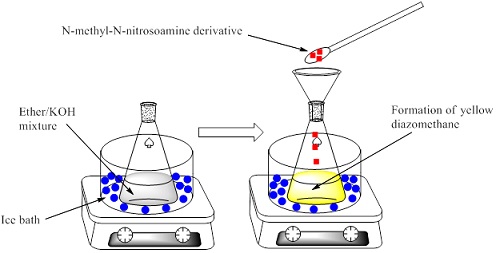Hazard Awareness
Diazomethane is a yellowish, explosive, and highly toxic gas with a boiling point of -23oC and a melting point of -145oC. It can be explosive in its pure and undiluted form but has also been known to detonate unexpectedly in the diluted form. Bright light, sharp/rough edges, and scratched glassware all have been known to trigger diazomethane explosions, as have certain metal ions in drying agents (e.g., CaCl2, MgSO4, CaSO4, Na2SO4).
In addition to its explosive nature, diazomethane is an irritant and highly toxic (more toxic than hydrogen cyanide) by inhalation or contact with skin or eyes. It is also a sensitizer, and long term exposures can lead to asthma-like symptoms, including chest discomfort, headache, weakness, and/or collapse. This comparison of the permissible exposure level (PEL) for a time-weighted average concentration (TWA) for diazomethane with that of hydrogen cyanide illustrates its extremely hazardous nature:
OSHA PEL (diazomethane) – 0.2 ppm TWA
OSHA PEL (hydrogen cyanide) – 10 ppm TWA
Diazomethane is useful as a powerful and fast acting alkylating agent and carbene source for laboratory-work; however, these same characteristics make it an equally powerful genotoxic compound. Inexperienced laboratory workers should not attempt to create or manipulate diazomethane reactions without first getting guidance from senior laboratory personnel. Whenever possible, trimethylsilyldiazomethane (also known as TMS-diazomethane, CAS# 18107-18-1) should be used in place of diazomethane because it is less likely to explode.
Protective Equipment
Work involving diazomethane should be carried out only within a properly functioning chemical fume hood with some form of shielding being used. Diazomethane distillations must use a blast shield that protects the researcher from the apparatus without hindering his/her ability to manipulate the experiment. Standard laboratory personal protective equipment (PPE) (laboratory coat, safety eye wear, and gloves) should be used when working with diazomethane; due to the chemical’s explosive and highly toxic nature, a face shield and double gloving are recommended.
Blast shield
Researcher using hood sashes as a shield
Emergency Response
Spills of diazomethane should be handled with the utmost urgency. If a spill happens inside a chemical fume hood, immediately close the sashes and let it evaporate; activate the emergency exhaust (if equipped). Immediately evacuate the lab if there is a large spill (>100 ml) outside of the chemical fume hood. Open the chemical fume hood sashes if possible before evacuating and activate fire alarms to alert others to evacuate the building. For small spills (<100 mL), it is probably enough to evacuate the lab.
First aid for diazomethane inhalations is immediate exposure to fresh air followed by prompt care at an emergency room. Because a Safety Data Sheet (SDS) of diazomethane is not available (it is too dangerous to transport), take the SDS for TMS-Diazomethane to inform emergency health care workers of diazomethane’s hazards.
Eye and skin exposures should be treated by flushing with large quantities of water for 15 minutes. Adding soap for skin exposures can help neutralize diazomethane by allowing it to react with a substrate.
Generation
Working with diazomethane in its pure and undiluted form is discouraged because it is so dangerous. Diluting it in diethyl ether as described below is highly recommended. If work with concentrated diazomethane is unavoidable, specialized diazomethane distillation equipment (flame-polished joints) is commercially available along with instructions (Sigma-Aldrich Co. LLC). TMS-diazomethane is a convenient and safer (not explosive) substitute for diazomethane, although it is also highly toxic.

Procedure
Use a new 500 ml Erlenmeyer flask that is free of scratches or chips and equipped with a magnetic stir bar. Ground glass joints should also be avoided. Add 40% aqueous potassium hydroxide solution (~50-100 ml) and diethyl ether (~100-200 ml). Place this flask into an ice bath on top of a magnetic stirrer. Let the mixture stir at a moderate rate until the ether layer has had time to chill. Add portion-wise a N-methyl-N-nitrosoamine derivative of your choice. Add only one spatula at a time, and wait approximately two minutes between additions while keeping the ethereal mixture cold throughout. Critical Note: To avoid explosions, stir the ethereal/KOH solution vigorously enough to avoid localized variations in concentration and temperature once the N-methyl-N-nitrosoamine derivative is added. This is also the reason for slow, portion-wise additions of the N-methyl-N-nitrosoamine derivative.
As the nitrosoamine derivative is added, the ether layer will gradually become more yellow. After adding ~10-15 grams of the nitrosoamine derivative, the ether layer should have a bright yellow color. Depending on the nitrosoamine derivative, this should yield approximately 50-150 mmols of diazomethane. It is now ready for use. The generated diazomethane has been dissolved in the ether layer (hence the yellow color) and can be decanted into a container to be placed in storage for short periods of time (see Storage section below), or it can be used immediately. When transferring solutions of diazomethane, use plastic (i.e., funnels, pipettes) when possible; sharp/rough edges and scratched glassware can cause diazomethane to detonate. If the concentration determination of the diazomethane solution is desired, perform a titration of the yellow diazomethane solution with benzoic acid. See all three Organic Syntheses references in this document for anhydrous synthesis of diazomethane.

Quenching
Do not dispose of diazomethane solutions via normal waste streams due to its explosive and highly toxic nature. Quench diazomethane first and then dispose of it through normal waste streams.
To quench excess diazomethane, add a few drops of acetic acid into the reaction mixture. Add drops of acetic acid until the yellow color of the diazomethane disappears and it stops producing nitrogen gas bubbles. This also applies to the residual KOH solution left over from the diazomethane generation procedure. Add acetic acid until the yellow color disappears. The excess diazomethane will react with the acetic acid to produce methyl acetate.
Storage
Storage of diazomethane solutions is highly discouraged!
It is best to make small amounts of diazomethane as needed, but if the work being done requires periodic small amounts then store ethereal solutions of diazomethane in a freezer in a tightly stoppered (rubber stopper) bottle that has been parafilm-sealed. Do not store diazomethane below its melting point (-145oC) as this may cause crystallization that triggers an explosion; avoid cryogenic storage of diazomethane outside the use of dry ice or a freezer. Due to diazomethane’s explosive and highly toxic nature, it should be stored in a freezer only for short periods of time (one to two weeks). Be sure the bottle has no scratches and place a few pellets of potassium hydroxide in it as a drying agent. Do not use any other drying agent, as diazomethane will react with certain metal ions to cause explosions. Be sure to indicate the contents on the container label. The precursors (e.g., diazald, N-nitrosomethylurea) should be stored in a refrigerator to help reduce reagent degradation and enhance reagent quality.
References
Vogel’s Textbook of Practical Organic Chemistry 5th Ed., B.S. Furniss; A.J. Hannaford; P.W.G. Smith; A.R. Tatchell, Longman Group UK Limited, 1989, ISBN 0-582-46236-3
Bretherick’s Handbook of Reactive Chemical Hazards 6th Ed., P.G. Urben (Ed.), Oxford, Butterworth-Heinemann, 1999, ISBN 0-7506-3605-X
Handbook of Reagents for Organic Synthesis – Reagents, Auxillaries and Catalysts for C-C Bond Formation, edited by Robert M. Coates and Scott E. Denmark, John Wiley & Sons, Inc., 1999, ISBN 0-471-97924-4
T. H. Black, Aldrichimica Acta, Vol. 16, Issue 1, 1983, pg.3-10.
Large scale batch process for diazomethane. US Patent No. 5817778, Oct. 6, 1998.
Organic Syntheses, Coll. Vol. 2, p.165, 1943.
Organic Syntheses, Coll. Vol. 4, p.250, 1963; Vol. 36, p.16, 1956.
Organic Syntheses, Coll. Vol. 5, p.351, 1973; Vol. 41, p.16, 1961.
NIOSH Pocket Guide to Chemical Hazards, DHHS (NIOSH) Publication No. 2005-149, Sep. 2007.